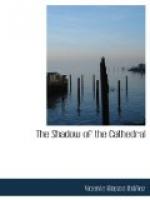The seminarist found examples of every sort of architecture that had flourished in the Peninsula. The primitive Gothic was found in the earliest doorways, the florid in those del Perdon and de los Leones, and the Arab architecture showed its graceful horseshoe arches in the triforium running round the whole abside of the choir, which was the work of Cisneros, who, though he burnt the Moslem books, introduced their style of architecture into the heart of the Christian temple. The plateresque style showed its fanciful grace in the door of the cloister, and even the chirruguesque showed at its best in the famous lanthorn of Tome, which broke the vaulting behind the high altar in order to give light to the abside.
In the evenings of the vacation Gabriel would leave the seminary, and wander about the Cathedral till the hour at which its doors were closed. He delighted in walking through the naves and behind the high altar, the darkest and most silent spot in the whole church. Here slept a great part of the history of Spain. Behind the locked gates of the chapel of the kings, guarded by the stone heralds on pedestals, lay the kings of Castille in their tombs, their effigies crowned, in golden armour, praying, with their swords by their sides. He would stop before the chapel of Santiago, admiring through the railings of its three pointed arches the legendary saint, dressed as a pilgrim, holding his sword on high, and tramping on Mahomedans with his war-horse. Great shells and red shields with a silver moon adorned the white walls, rising up to the vaulting, and this chapel his father, the gardener, regarded as his own peculiar property. It was that of the Lunas, and though some people laughed at the relationship, there lay his illustrious progenitors, Don Alvaro and his wife, on their monumental tombs. That of Dona Juana Pimental had at its four corners the figures of four kneeling friars in yellow marble, who watched over the noble lady extended on the upper part of the monument. That of the unhappy constable of Castille was surrounded by four knights of Santiago, wrapped in the mantle of their Order, seeming to keep guard over their grand master, who lay buried without his head in the stone sarcophagus, bordered with Gothic mouldings. Gabriel remembered what he had heard his father relate about the recumbent statue of Don Alvaro. In former times the statue had been of bronze, and when mass was said in the chapel, at the elevation of the Host, the statue, by means of secret springs, would rise and remain kneeling till the end of the ceremony. Some said that the Catholic queen caused the disappearance of this theatrical statue, believing that it disturbed the prayers of the faithful; others said that some soldiers, enemies of the constable, on a day of disturbance, had broken in pieces the jointed statue. On the exterior of the church the chapel of the Lunas raised its battlemented towers, forming an isolated fortress inside the Cathedral.




